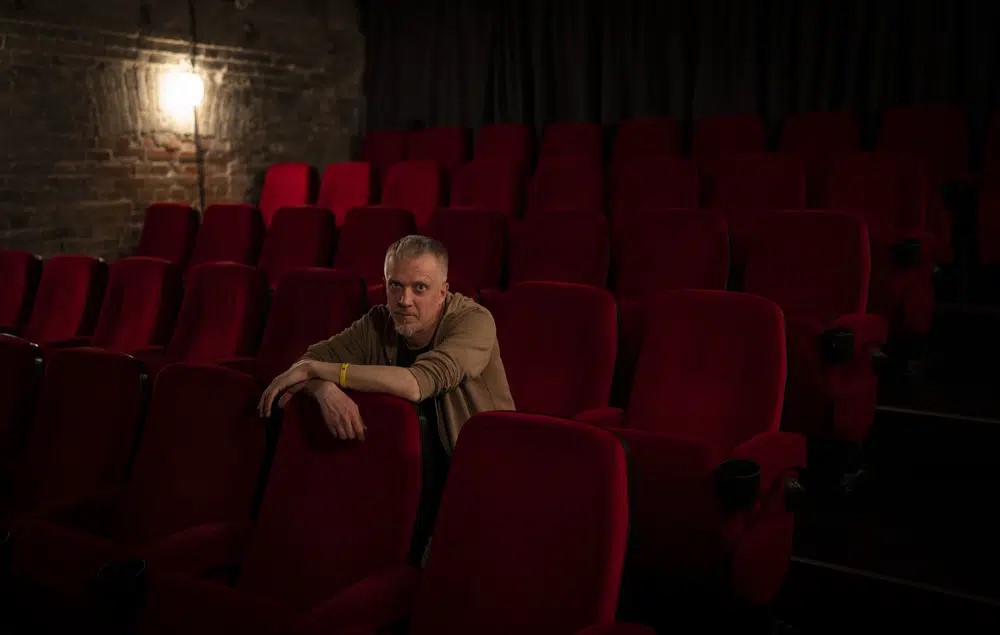“10 By 10 in the Triangle” opened Friday and runs through July 27, with shows Thursdays, Fridays, and Saturdays at 8:00 p.m. and Sundays at 3:00. Visit ArtsCenterLive.org for more details.
“What is that guy doing up there on stage?” I ask.
“I don’t know,” says my friend Kit. “But that is one awesome smoking jacket he’s wearing.”
It’s 7:55 on Friday evening and the curtain’s about to go up on the ArtsCenter’s thirteenth annual “10 By 10 in the Triangle” show – an evening of ten short plays, each about ten minutes long, performed by a cast of ten actors with ten different directors. It’s opening night and the place is buzzing. I’ve never seen a “10 By 10” show, but it’s a major event on the ArtsCenter’s yearly calendar: the ten plays were chosen from 750 submissions that came in from around the world, they’ve been working on it for months, and just scanning the audience, it’s obvious it’s kind of a big deal. The room is packed. All the local luminaries are there. Town leaders, theater royalty. Kit and I are sitting next to Lydia Lavelle.
Smoking Jacket Guy is David Berberian, as it turns out – one of the ten actors, already in character as the arrogant master thespian Vincent Van Buren, strutting about the stage, gladhanding the audience members in the pit (one of whom turns out to be a second actor, planted in the front row). The show begins, officially, when Berberian butts in on artistic director Jeri Lynn Schulke’s opening spiel – though not until she proclaims this to be the best “10 By 10” yet.
(My actress friend Amanda is a veteran from previous “10 By 10” shows; she was in the audience with another past-show veteran. “We were like, ‘hey!’” she joked.)
The first play alone features an actor being pulled on stage from the audience, a surprise entrance from outside, a character in disguise as himself, and a hilarious “Shakespeare-off” where the lines may or may not actually be from Shakespeare. (I won’t spoil it.) All that in ten minutes. It’s chaotic, it’s unexpected, and it’s hilarious – a great opening play, and a perfect introduction to a show that (by its nature) is going to be a scattershot grab bag of diverse scenes, styles, emotions, and endings.
If you’re looking for a cost-efficient night out, “10 By 10” is the show for you. For one price, you get ten plays. There’s something in it for just about everyone. Will you love every play? Almost certainly not – they’re too diverse for that. But there will be something in it that you will love. By the time we walked out of the theater, two and a half hours later, we’d seen six love stories, two riffs on modern technology, and three takes on the theater itself; we’d seen men and women fly, die and return to life; we’d seen the concealing power of light and the revealing power of darkness; and there may or may not have been a naked guy. (I won’t spoil that either.)
Jeri Lynn Schulke joined me on the Afternoon News earlier this week to talk about the show. Here’s our conversation.
Overall – is it good? Yes. It’s a fun night out. You should definitely go.
How about each individual play?
Well, that’s a little trickier. Short plays do tend to follow a sort of template – like short stories, they tend to focus on particularly intense moments (blind dates, jarring revelations, the confrontation with death) and build toward what James Joyce referred to as an “epiphany,” a sudden overwhelming final realization that changes everything. So you’ll see a lot of recurring themes and patterns in these plays. Still, there’s a lot of room to move within that broad category – and because the plays in “10 By 10” are so diverse, different people will feel differently about each one. (You could tell that much sitting in the theater, where – for reasons we never quite figured out – the right-hand side of the audience was laughing more than the left.)
So it’s only fair that a review of “10 By 10” should incorporate several different perspectives. I compared notes with Kit and Amanda (both seasoned theater folks) – and between the three of us, notwithstanding some differences of opinion, we actually did come to a pretty solid consensus.
Among the ten actors, we kept coming back to two. David Berberian – the aforementioned Smoking Jacket Guy – delivers an especially strong performance; you see him in three wildly different roles and he disappears into each one. Also noteworthy is Caroline Strange, who’s prominently featured in the two best plays of the show (though she’s typecast a bit as an immature millennial in two of her three roles). Beyond that, Lazarus Simmons only has one major role, in a play called “Canyon,” but he makes it count. Page Purgar is also worth noting: she actually has three big roles, but she’s especially terrific paired with Berberian as a Catholic school teacher in a play called “Recess at Our Lady of the Bleeding Heart, Mind, and Spirit.” (“Recess” wasn’t our favorite play, but we generally agreed that it was the best-acted.)
The show is divided into two acts of five plays each. In the first act, the standout is “Canyon,” featuring Strange as a young woman planning to jump off the Grand Canyon (she thinks she can fly) and Simmons and Jillian Lea as a couple trying to stop her. In the second act, it’s “Lost in Thought,” a David Ives-esque piece with Jorge Donoso (also good in four very different roles) as a young man reflecting on a relationship turned sour. (Strange plays the ex-girlfriend; Simmons plays her new squeeze.) Of the ten plays, “Lost in Thought” is the only one that’s not a comedy; it was also easily our favorite, with “Canyon” a close second. They’re extremely well-acted, well-directed by Hope Alexander (“Lost”) and Lori Mahl (“Canyon”) – and remember I mentioned the “epiphany” that often comes at the end of short plays? These two earn their epiphanies. (Trust me, you will remember their last lines.)
As for the other eight: we loved “What the Theatre is All About,” the anarchic opening play with Berberian and Fred Corlett as dueling Master Thespians. We also really enjoyed “Recess,” again mostly for the terrific acting. We liked “Going Viral,” about a teenager (Donoso) who learns that his parents have made him an unwitting YouTube celebrity – but we agreed that it felt more like a sketch than a play. (No epiphany, I guess.) One of us loved “The Interpreter,” about a dating service that live-tweets your blind dates, but the other two were slightly turned off by Strange’s character (the live-tweeter), who came off as a bit shrill. (This is one of her two immature-millennial characters; the other one is in “Canyon,” more chill than shrill, and it’s great.)
There are two plays, “Ten Minute Life” and “This Is Not A Play,” both of which are about the process of writing a ten-minute play; we didn’t much care for either one (too meta!), but we all agreed that “This Is Not A Play” was more successful. (“Ten Minute Life,” our least favorite, tries to build to an epiphany that it doesn’t really earn; it’s too self-referential to be realistically emotional. Two of us actually liked “This Is Not A Play,” but we all agreed it would have been better as a five-minute piece.) We also weren’t sold on “The Wisdom of Pirates,” about a woman who decides to wear an eyepatch; there wasn’t anything inherently wrong with it, but we didn’t buy the epiphany there either. (One of us said, “It thinks it’s smarter than it actually is.”)
And the show closes with a surreal pastiche called “A Streaker Named Desire,” which was really the only one that divided us: one of us liked it, one of us hated it, and one of us liked most of it but didn’t buy the ending. We’ll leave the final judgment up to you.






Comments on Chapelboro are moderated according to our Community Guidelines